Flow Field in Slab Continuous Casting Mold with Large Width Optimized with High Temperature Quantitative Measurement and Numerical Calculation
Abstract
:1. Introduction
2. High Temperature Velocity Measurement Method
3. Mathematical Model
3.1. Numerical Simulation
3.2. Governing Equation
3.3. Computational Domain and Boundary Conditions
4. Results and Discussion
4.1. Effect of Argon Gas Flow Rate
4.2. Effect of Casting Speed
4.3. Effect of Immersion Depth
4.4. Effect of SEN Bottom Shape
5. Conclusions
- (1)
- Under the conditions of the large mold width of 1800 mm, 1.1 m/min casting speed and 140 mm SEN immersion depth, the velocity near the mold surface decreases with increasing the argon gas flow rate. The calculated results match very well with the measured results. When the argon gas flow rate is 6 L/min, the flow pattern is the double roll flow (DRF), and the liquid level fluctuation is small. When the argon gas flow rate is increased to 10 and 14 L/min, the flow pattern is the single roll flow (SRF), the liquid level fluctuation is large, and the risk of slag entrainment increases.
- (2)
- When the mold width is 1800 mm, the argon gas flow rate is 10 L/min, and the immersion depth is 160 mm, the velocity near the mold surface sensitively increases with increasing casting speed. The calculated results are consistent with the measured ones. When the casting speed is 1.1 m/min, the direction of the velocity near the mold surface is from SEN to narrow wall, forming an intermediate flow (IF). The mold surface fluctuation is obviously intensified, which is easy to cause slag entrainment defects. When the casting speed is only increased to 1.2 m/min, the velocity near the mold surface changes drastically and is close to 0.4 m/s, which is the upper limit velocity near the mold surface. Therefore, the optimized casting speed should be larger than 1.1 m/min and smaller than 1.2 m/min.
- (3)
- When the mold width is 1800 mm, the casting speed is 1.1 m/min, and the argon gas flow rate is 10 L/min, the velocity near the mold surface is obviously increased with the increasing immersion depth. The calculated results are also in accord with the measured ones. When the immersion depth of the nozzle is 140 and 160 mm, the velocity near the mold surface is from SEN to narrow wall, the flow pattern is SRF or IF, and the liquid level fluctuates greatly. When the immersion depth of the SEN is 180 mm, the velocity near the mold surface is from narrow wall to the SEN, the flow pattern is DRF, and the fluctuation of the liquid level is small, which is conducive to control the risk of slag entrainment.
- (4)
- When the bottom shape of the SEN changes from a mountain to a well, the velocity near the mold surface decreases from 0.4 to 0.25 m/s under the conditions of 2000 mm mold width, 1.0 m/min casting speed, 8 L/min argon gas flow rate and 150 mm SEN immersion depth. Because the velocity near the mold surface with the mountain shaped nozzle is too large and the liquid level fluctuates greatly, it is suggested to adopt the well-shaped nozzle to reduce the risk of slag entrainment.
Author Contributions
Funding
Institutional Review Board Statement
Informed Consent Statement
Data Availability Statement
Conflicts of Interest
References
- Bessho, N.; Yoda, R.; Yamasaki, H.; Fujii, T.; Nozaki, T.; Takatori, S. Numerical analysis of fluid flow in continuous casting mold by bubble dispersion model. ISIJ Int. 1991, 31, 40–45. [Google Scholar] [CrossRef] [Green Version]
- Chen, Y.; Zhang, J.M.; Han, L.H. Numerical simulation on fluid flow in mold for wide slab continuous casting. Res. Iron Steel. 2008, 36, 10–13. [Google Scholar] [CrossRef]
- Chen, Y.; Zhang, J.M. Water model experiment on argon gas distribution in wide slab casting mold. J. Iron Steel Res. 2008, 20, 17–20. [Google Scholar]
- Chen, Y.; Zhang, J.M.; Wang, S.Z. Water model experiments on surface flow fluctuation patterns in wide slab caster mold. Steelmaking 2008, 24, 43–46. [Google Scholar]
- He, K.N.; Xiao, J.G.; Wei, Y.H.; Sun, Y.H.; Liao, W.T. Experimental research on structure of submerged entry nozzle and operation parameter optimization for wide slab continuous casting mold. Iron Steel. 2008, 43, 26–29. [Google Scholar]
- Liu, G.L.; Wu, S.Z.; Zhang, J.M.; Wang, W.J.; Wang, X.H. Numerical simulation on the surface fluctuation of molten steel in a wide slab continuous casting mold. Chin. J. Eng. 2009, 31, 229–233. [Google Scholar]
- Lin, X.C.; Li, J.S.; Zhang, X.L.; Liang, X.W. Water model experiments on surface flow velocity of molten steel in slab caster mold. Chin. Metall. 2010, 20, 15–19. [Google Scholar]
- Wang, H.X.; Cao, M.L.; Liu, Z.G. Analysis and control on mold level fluctuation. Steelmaking 2012, 28, 37–41. [Google Scholar]
- Garcia-hernandez, S.; Morales, R.D.; Barreto, J.D.J.; Morales-Higa, K. Numerical optimization of nozzle ports to improve the fluidynamics by controlling backflow in a continuous casting slab mold. ISIJ Int. 2013, 53, 1794–1802. [Google Scholar] [CrossRef] [Green Version]
- Liu, Z.Q.; Li, B.K.; Jiang, M.F.; Tsukihashi, F. Modeling of transient two-phase flow in a continuous casting mold using euler-euler large eddy simulation scheme. ISIJ Int. 2013, 53, 484–492. [Google Scholar] [CrossRef] [Green Version]
- Ramos, I.C.; Morales, R.D.; Garcia-hernandez, S.; Ceballos-Huerta, A. Effects of immersion depth on flow turbulence of liquid steel in a slab mold using a nozzle with upward angle rectangular ports. ISIJ Int. 2014, 54, 1797–1806. [Google Scholar] [CrossRef] [Green Version]
- Xiong, X.; Deng, X.X.; Wang, X.H.; Huang, Q.; Zhang, H.B. Effect of port-shape design on fluid flow in high-speed slab continuous casting mold. J. Iron Steel Res. 2014, 26, 35–40. [Google Scholar]
- Ren, L.; Zhang, L.F.; Wang, Q.Q.; Zhao, X. Study on fluid flow in a continuous casting slab mold using particle image velocimetry. Chin. J. Eng. 2016, 38, 1393–1403. [Google Scholar]
- Kato, T.; Hara, M.; Muto, A.; Hiraki, S.; Kawamoto, M. Fluid flow behavior in submerged entry nozzle of continuous casting. ISIJ Int. 2007, 47, 840–846. [Google Scholar] [CrossRef] [Green Version]
- Tsukaguchi, Y.; Hayashi, H.; Kurimoto, H.; Yokoya, S.; Marukawa, K.; Tanaka, T. Development of swirling-flow submerged entry nozzles for slab casting. ISIJ Int. 2010, 50, 721–729. [Google Scholar] [CrossRef] [Green Version]
- Deng, X.X.; Ji, C.X.; Cui, Y.; Zhu, G.S.; Li, L.P.; Suo, J.L. Flow pattern in continuous casting slab mold with argon blowing. Iron Steel. 2016, 51, 23–30. [Google Scholar]
- Deng, X.X.; Wang, X.H.; Li, L.P.; Yang, D.; Ji, C.X. Effect of nozzle bottom design on jet characteristics in continuous casting slab mold for high speed casting. Steelmaking 2014, 30, 44–48. [Google Scholar]
- Deng, X.X.; Ji, C.X.; Li, L.P.; Yin, X.; Yang, Y.; McLean, A. Flow pattern control in continuous slab casting moulds: Physical modelling and plant trials. Ironmak. Steelmak. 2017, 44, 461–471. [Google Scholar] [CrossRef]
- Chen, G.; Zhou, H.L.; Yu, L.; Zhong, L.C.; Zhang, K.J. Influence of submerged immersion nozzle structure on liquid surface fluctuation in slab continuous casting mold. Steelmaking 2018, 34, 50–56. [Google Scholar]
- Cho, S.M.; Thomas, B.G.; Kim, S.H. Effect of nozzle port angle on transient flow and surface slag behavior during continuous steel-slab casting. Metall. Mater. Trans. B 2018, 50, 52–76. [Google Scholar] [CrossRef]
- Iguchi, M.; Kawabata, H.; Demoto, Y.; Morita, Z.-I. Cold model experiment for developing a new velocimeter applicable to molten metal. Tetsu-to-Hagane 1993, 79, 1046–1052. [Google Scholar] [CrossRef] [Green Version]
- Iguchi, M.; Terauchi, Y. Karaman vortex probe for the detection of molten metal surface flow in low velocity range. ISIJ Int. 2002, 42, 939–943. [Google Scholar] [CrossRef]
- McDavid, R.M.; Thomas, B.G. Flow and thermal behavior of the top surface flux/powder layers in continuous casting mold. Metall. Mater. Trans. B 1996, 27, 672–685. [Google Scholar] [CrossRef]
- Zhang, T.; Yang, J.; Jiang, P. Measurement of molten steel velocity near the surface and modeling for transient fluid flow in the continuous casting mold. Metals 2019, 9, 36. [Google Scholar] [CrossRef] [Green Version]
- Zhang, T.; Yang, J.; Xu, G.J.; Liu, H.J.; Zhou, J.J.; Qin, W. Effect of operation parameters on flow field in slab continuous casting mold with narrow width. Int. J. Miner. Metall. Mater. 2020. [Google Scholar] [CrossRef]
- Jiang, P.; Yang, J.; Zhang, T.; Xu, G.J.; Liu, H.J.; Zhou, J.J.; Qin, W. Optimization of flow field in slab continuous casting mold with medium width using high temperature measurement and numerical simulation for automobile exposed panel production. Metals 2019, 10, 9. [Google Scholar] [CrossRef] [Green Version]
- Jiang, P.; He, W.Y.; Qiao, H.S.; Zhao, C.L.; Zhang, T.; Yang, J. Optimization of mold flow field and SEN port shape in continuous casting of automobile exposed panel. Steelmaking 2020, 36, 34–44. [Google Scholar]
- Liu, Z.Q.; Li, L.M.; Qi, F.S.; Li, B.K.; Jiang, M.F.; Tsukihashi, F. Population balance modeling of polydispersed bubbly flow in continuous-casting using multiple-size-group approach. Metall. Mater. Trans. B 2014, 46, 406–420. [Google Scholar] [CrossRef]
- Kunstreich, S.; Dauby, P.H. Effect of liquid steel flow pattern on slab quality and the need for dynamic electromagnetic control in the mould. Ironmak. Steelmak. 2013, 32, 80–86. [Google Scholar] [CrossRef]
- Yoshida, J.; Iguchi, M.; Yokoya, S.-I. Water model experiment on mold powder entrapment around the exit of immersion nozzle in continuous casting mold. Tetsu-to-Hagane 2001, 87, 529–535. [Google Scholar] [CrossRef] [Green Version]
- Lu, Q.T.; Yang, R.G.; Wang, X.H.; Zhang, J.M.; Wang, W.J. Water modeling study on factors affecting mold powder entrapment in slab continuous casting. Iron Steel. 2006, 41, 29–32. [Google Scholar]
- Zhang, L.F.; Wang, Y.F.; Zuo, X.J. Flow transport and inclusion motion in steel continuous-casting mold under submerged entry nozzle clogging condition. Metall. Mater. Trans. B 2008, 39, 534–550. [Google Scholar] [CrossRef]
- Kubota, J.; Okimoto, K.; Shirayama, A. Meniscus flow control in the mold by traveling magnetic field for high speed slab caster. In Steelmaking Conference Proceedings; Iron and Steel Society: Warrendale, PA, USA, 1991; pp. 233–241. [Google Scholar]
- Liu, R.; Thomas, B.G.; Sengupta, J.; Chung, S.D.; Trinh, M. Measurements of molten steel surface velocity and effect of stopper-rod movement on transient multiphase fluid flow in continuous casting. ISIJ Int. 2014, 54, 2314–2323. [Google Scholar] [CrossRef] [Green Version]
- Zhang, L.F.; Yang, S.B.; Cai, K.K.; Li, J.Y.; Wan, X.G.; Thomas, B.G. Investigation of fluid flow and steel cleanliness in the continuous casting strand. Metall. Mater. Trans. B 2007, 38, 63–83. [Google Scholar] [CrossRef]
- Chaudhary, R.; Lee, G.G.; Thomas, B.G.; Kim, S.-H. Transient mold fluid flow with well- and mountain-bottom nozzles in continuous casting of steel. Metall. Mater. Trans. B 2008, 39, 870–884. [Google Scholar] [CrossRef] [Green Version]
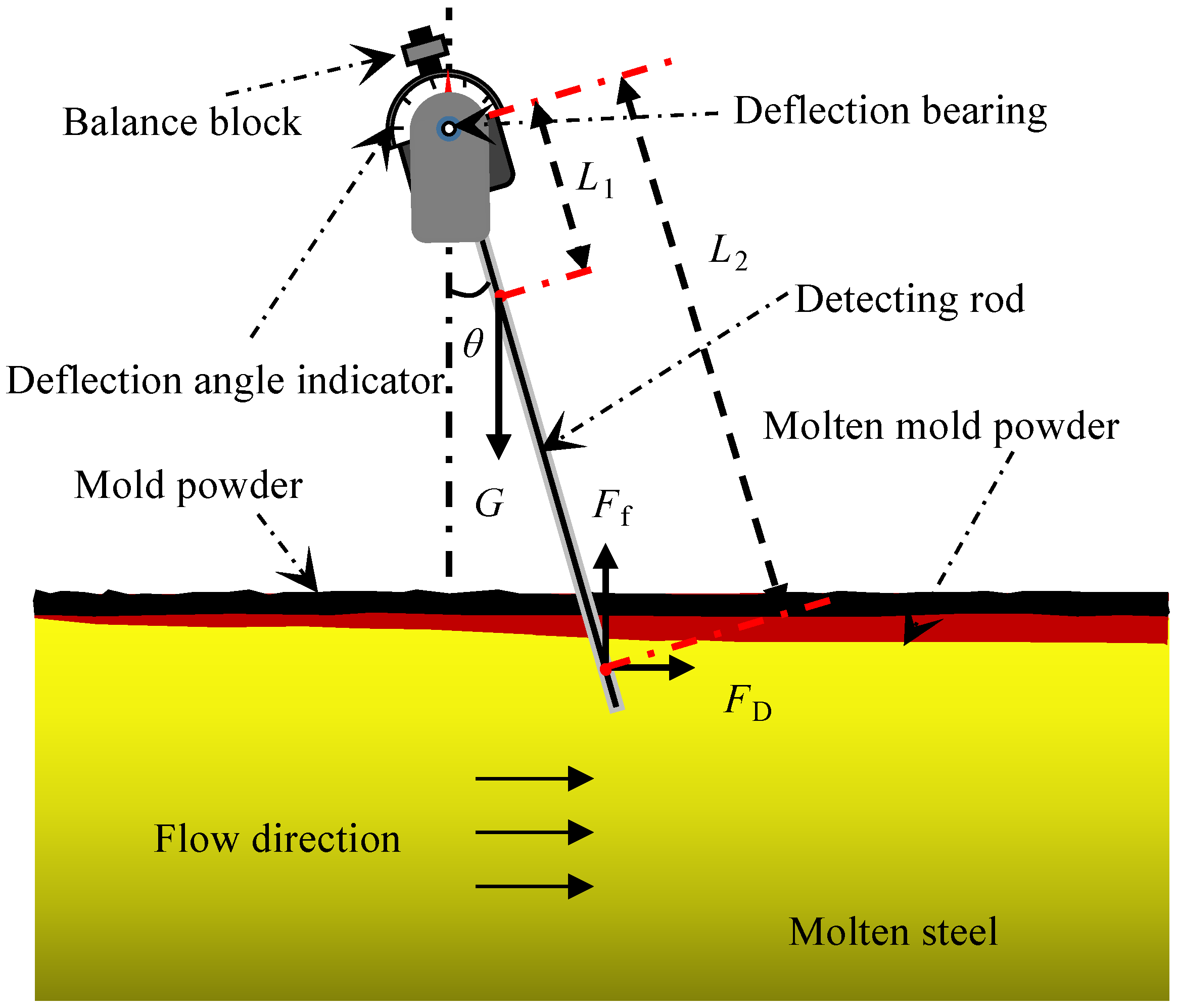


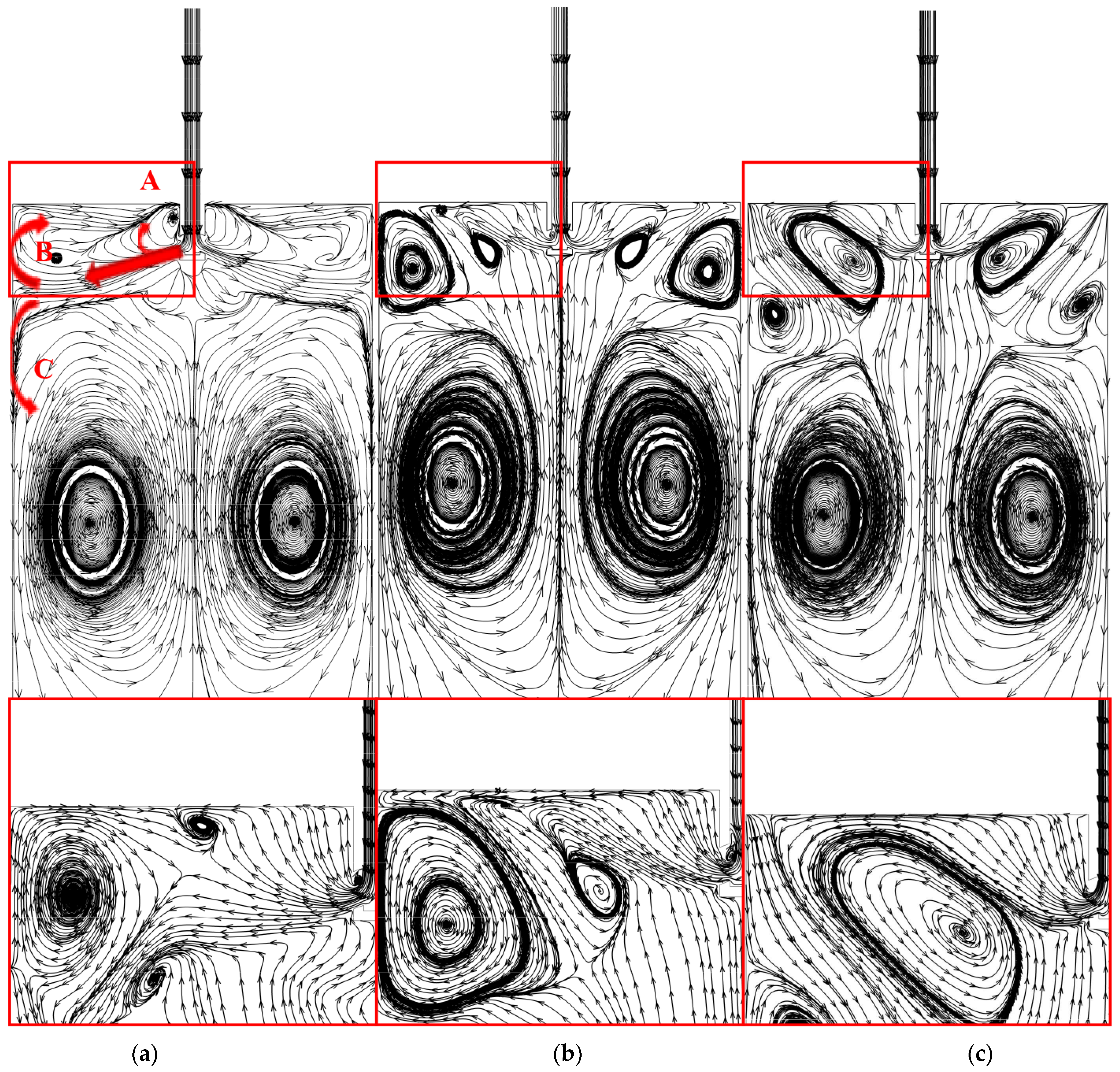

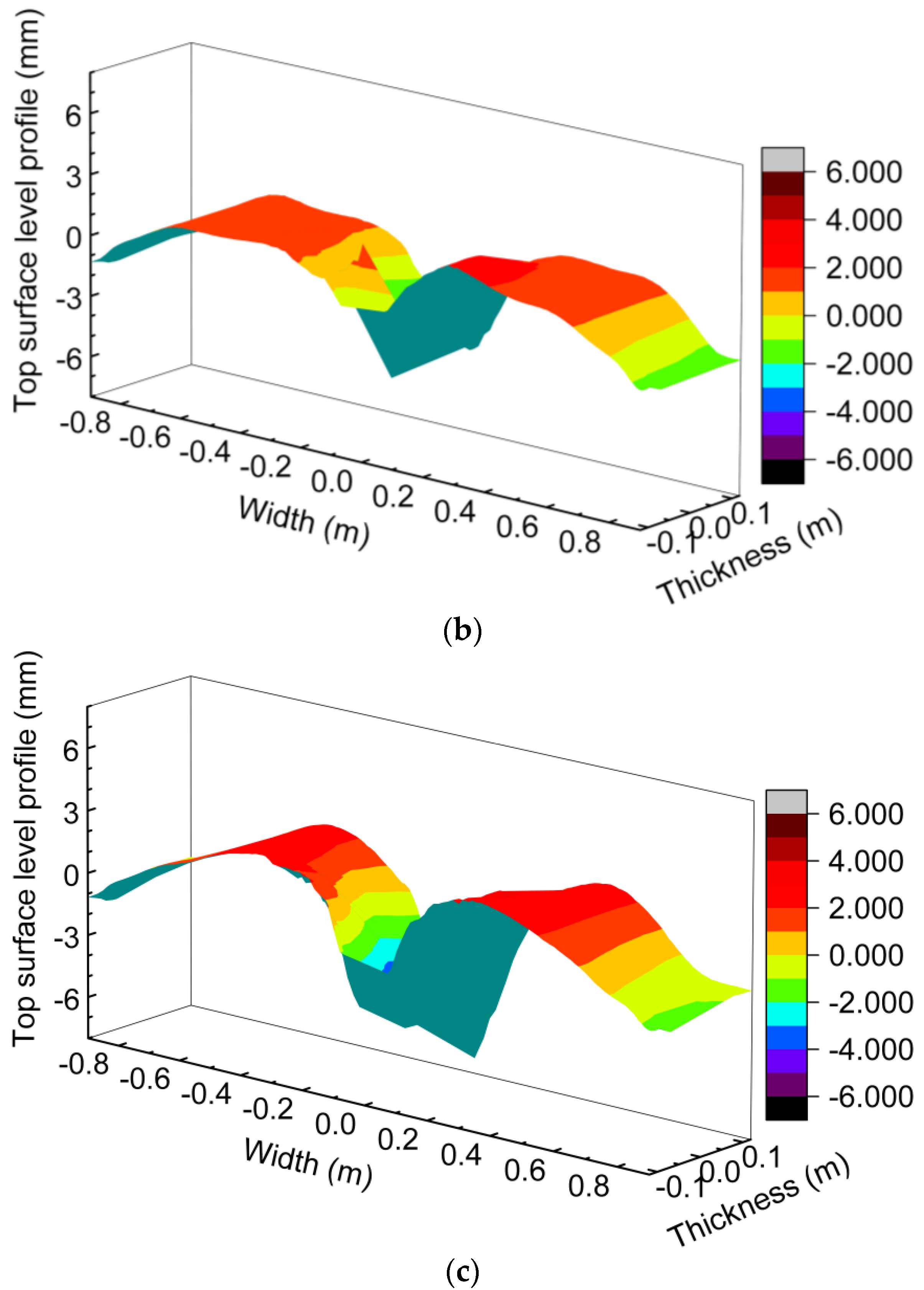

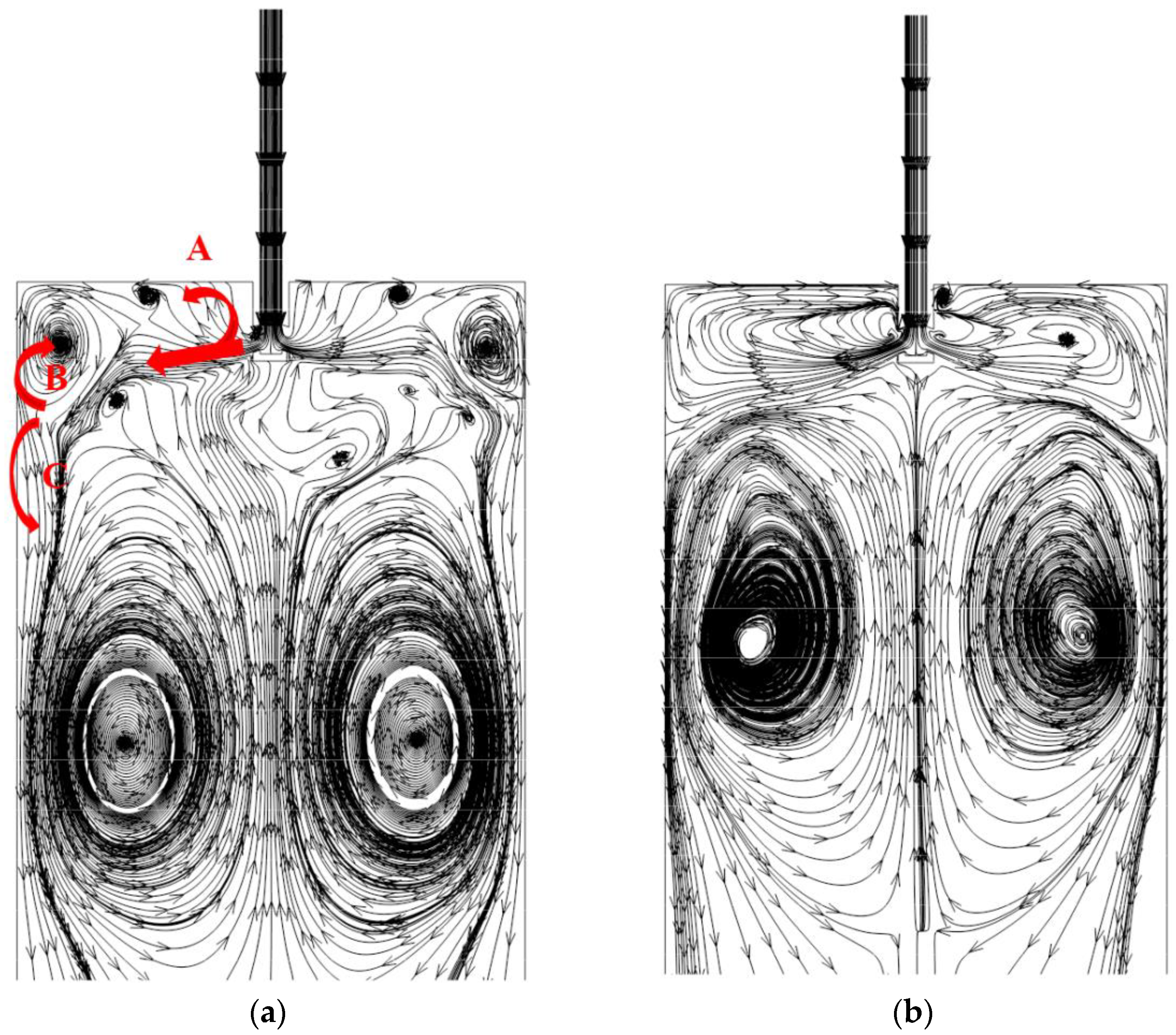
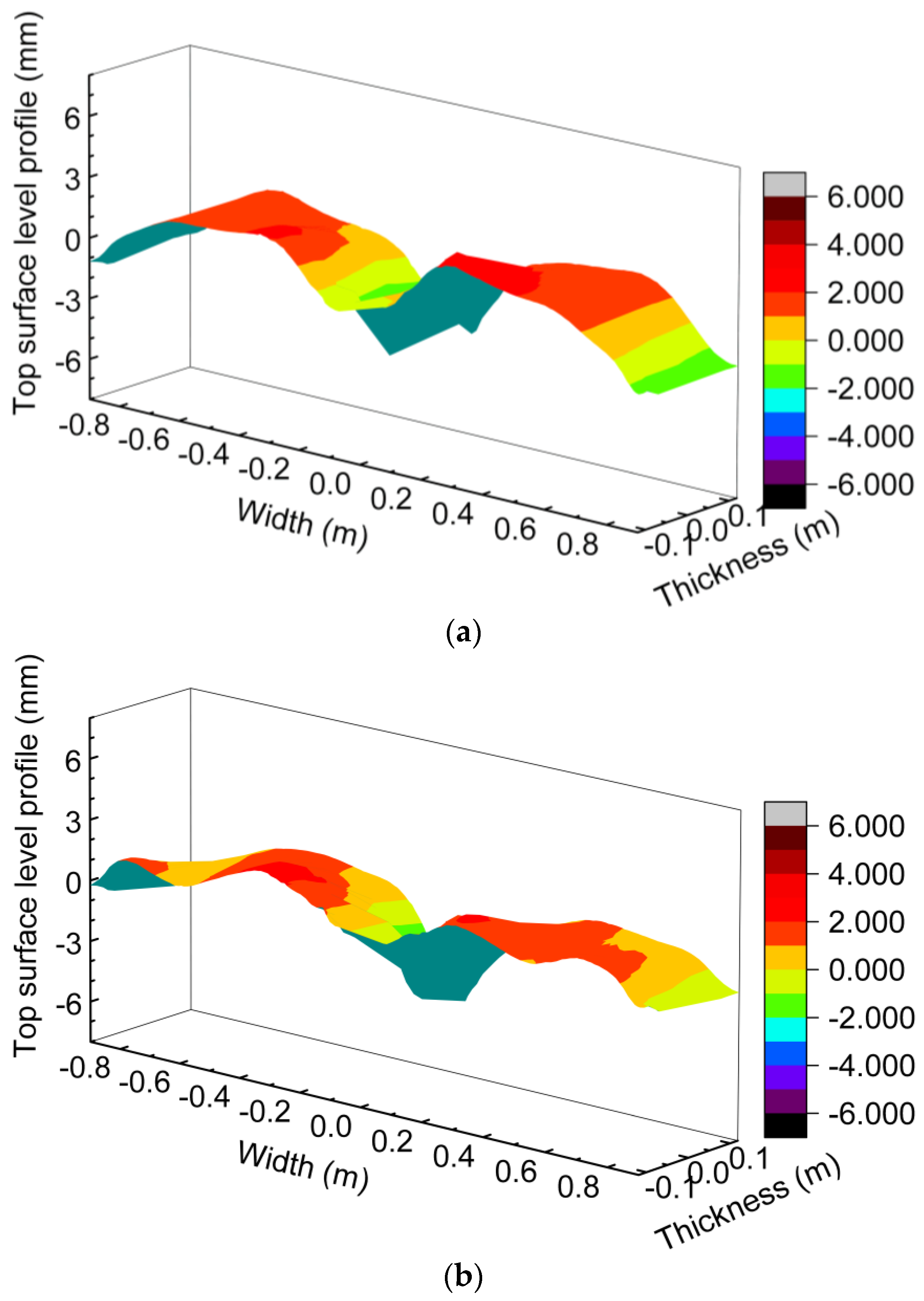
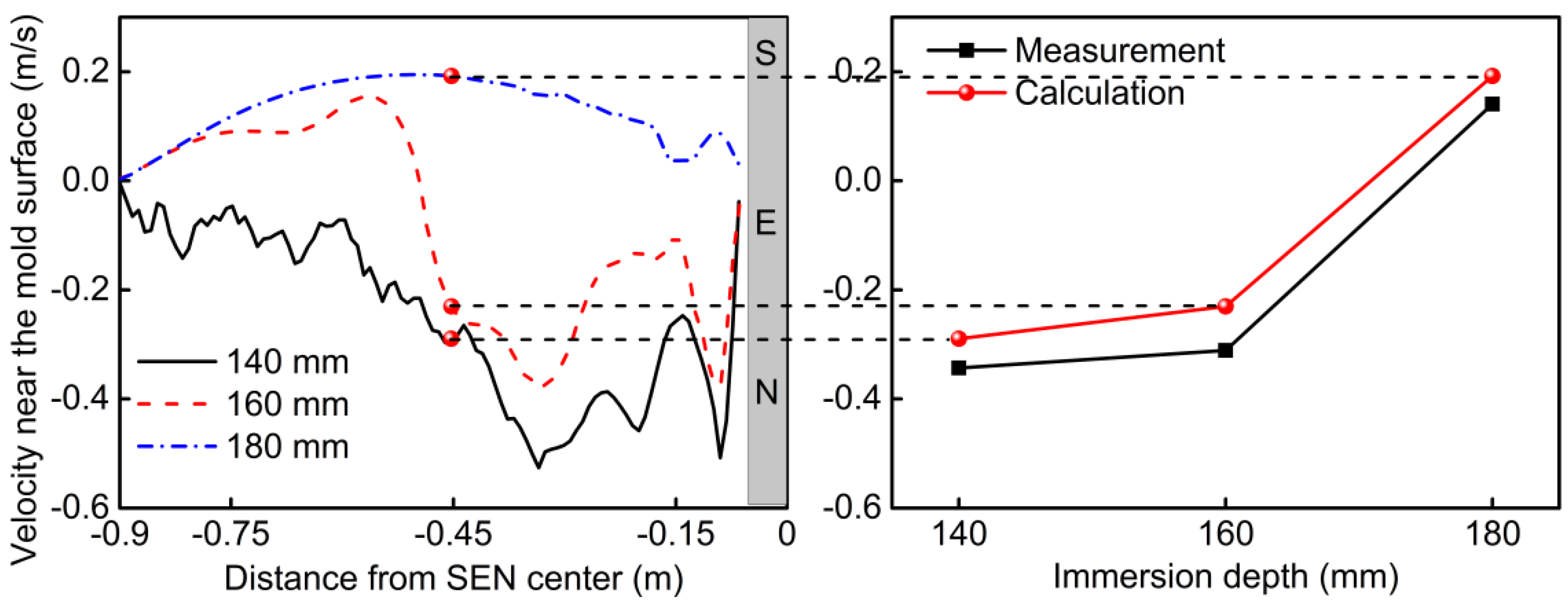
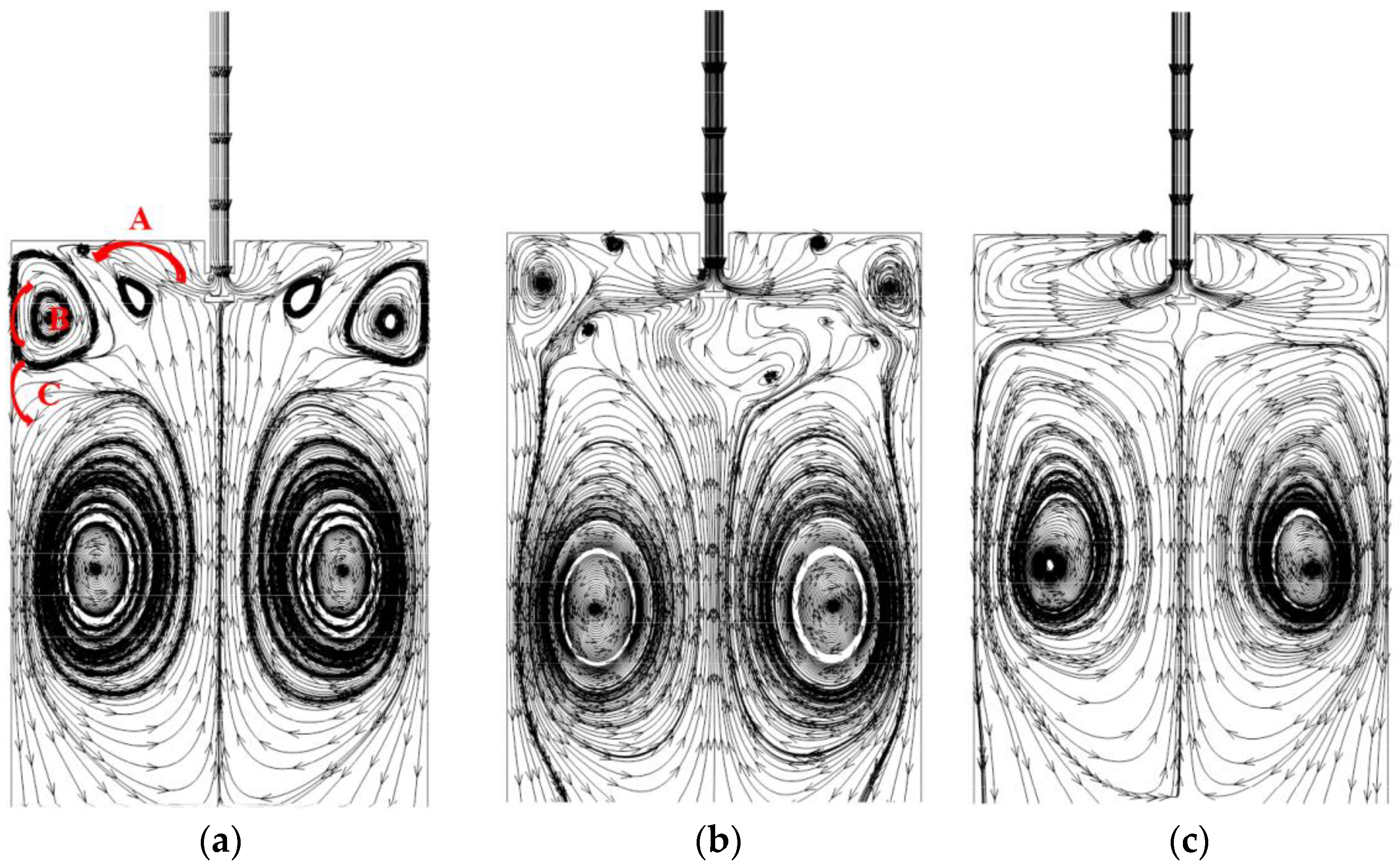





| Parameters | Values | Parameters | Values |
|---|---|---|---|
| Slab width (mm) | 1800, 2000 | Computational domain length (mm) | 2500 |
| Slab thickness (mm) | 237 | Argon gas flow rate (L/min) | 6, 8, 10, 14 |
| Casting speed (m/min) | 1.0, 1.1, 1.2 | Immersion depth of SEN (mm) | 140, 150, 160, 180 |
| SEN port angle (°) | −20 | SEN bottom shape | mountain, well |
| Fluid density (kg/m3) | 7020 | SEN port size (mm × mm) | 70 × 90 |
| Argon gas density (kg/m3) | 0.56 | Fluid dynamic viscosity (kg/m∙s) | 0.0055 |
Publisher’s Note: MDPI stays neutral with regard to jurisdictional claims in published maps and institutional affiliations. |
© 2021 by the authors. Licensee MDPI, Basel, Switzerland. This article is an open access article distributed under the terms and conditions of the Creative Commons Attribution (CC BY) license (http://creativecommons.org/licenses/by/4.0/).
Share and Cite
Ma, C.; He, W.-y.; Qiao, H.-s.; Zhao, C.-l.; Liu, Y.-b.; Yang, J. Flow Field in Slab Continuous Casting Mold with Large Width Optimized with High Temperature Quantitative Measurement and Numerical Calculation. Metals 2021, 11, 261. https://doi.org/10.3390/met11020261
Ma C, He W-y, Qiao H-s, Zhao C-l, Liu Y-b, Yang J. Flow Field in Slab Continuous Casting Mold with Large Width Optimized with High Temperature Quantitative Measurement and Numerical Calculation. Metals. 2021; 11(2):261. https://doi.org/10.3390/met11020261
Chicago/Turabian StyleMa, Chao, Wen-yuan He, Huan-shan Qiao, Chang-liang Zhao, Yi-bo Liu, and Jian Yang. 2021. "Flow Field in Slab Continuous Casting Mold with Large Width Optimized with High Temperature Quantitative Measurement and Numerical Calculation" Metals 11, no. 2: 261. https://doi.org/10.3390/met11020261





